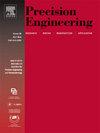Development of a novel nickel-based metal force microsensor using bottom-up approach
IF 3.5
2区 工程技术
Q2 ENGINEERING, MANUFACTURING
Precision Engineering-Journal of the International Societies for Precision Engineering and Nanotechnology
Pub Date : 2025-05-05
DOI:10.1016/j.precisioneng.2025.05.003
引用次数: 0
Abstract
The advancement of force microsensors has shifted towards alternative fabrication methods offering enhanced flexibility, cost efficiency, and adaptability. Traditional silicon-based sensors face limitations such as mechanical fragility, thermal expansion mismatches, and high fabrication costs, necessitating alternative approaches. This study explores a bottom-up fabrication approach using electro-galvanic deposition to develop nickel-based capacitive force microsensors. Unlike conventional methods, electro-galvanic deposition enables precise control over material thickness and microstructure, allowing for the fabrication of robust, metal-based sensors with superior toughness and mechanical reliability. Nickel, chosen for its high tensile strength, corrosion resistance, and adaptability to high temperatures, is well-suited for demanding applications. The fabrication process involves UV maskless lithography for mold patterning, followed by electro-galvanic deposition in a modified Watt's bath with saccharin additives to control grain structure. This enables fine-tuning of nickel's mechanical properties, enhancing hardness and ductility. The capacitive comb sensor structure, integrated with a high-resolution capacitance-to-digital converter, enables precise force measurements with a linear response and high sensitivity. Experimental validation included mechanical testing, calibration, and stability analysis under controlled loading conditions. Results confirmed a strong linear force-capacitance relationship (R2 = 0.9898) and excellent long-term stability, with minimal capacitance drift under sustained load.
基于自底向上方法的新型镍基金属力微传感器的研制
力微传感器的进步已经转向替代制造方法,提供增强的灵活性,成本效率和适应性。传统的硅基传感器面临机械脆弱性、热膨胀不匹配和高制造成本等限制,需要替代方法。本研究探索了一种自下而上的制造方法,利用电沉积来开发镍基电容力微传感器。与传统方法不同,电沉积可以精确控制材料厚度和微观结构,从而制造出具有优异韧性和机械可靠性的坚固金属基传感器。镍因其高抗拉强度、耐腐蚀性和对高温的适应性而被选中,非常适合要求苛刻的应用。制造过程包括用于模具图案的UV无掩模光刻,然后在带有糖精添加剂的改良瓦特浴中进行电沉积以控制晶粒结构。这使得镍的机械性能微调,提高硬度和延展性。电容梳状传感器结构与高分辨率电容-数字转换器集成,可实现具有线性响应和高灵敏度的精确力测量。实验验证包括机械测试、校准和受控载荷条件下的稳定性分析。结果表明,该材料具有较强的线性力-电容关系(R2 = 0.9898),且具有良好的长期稳定性,在持续负载下电容漂移极小。
本文章由计算机程序翻译,如有差异,请以英文原文为准。
求助全文
约1分钟内获得全文
求助全文
来源期刊
CiteScore
7.40
自引率
5.60%
发文量
177
审稿时长
46 days
期刊介绍:
Precision Engineering - Journal of the International Societies for Precision Engineering and Nanotechnology is devoted to the multidisciplinary study and practice of high accuracy engineering, metrology, and manufacturing. The journal takes an integrated approach to all subjects related to research, design, manufacture, performance validation, and application of high precision machines, instruments, and components, including fundamental and applied research and development in manufacturing processes, fabrication technology, and advanced measurement science. The scope includes precision-engineered systems and supporting metrology over the full range of length scales, from atom-based nanotechnology and advanced lithographic technology to large-scale systems, including optical and radio telescopes and macrometrology.

 求助内容:
求助内容: 应助结果提醒方式:
应助结果提醒方式:


